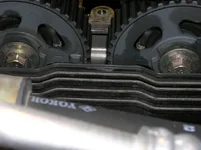Odd Situation - Contradicts Manual
Novice, this is how I initially had timing set up and I wasn't even close to starting. Got backfire through the intake and the motor rolled over very inconsistently-- obvious out of time.
Now this is the correct setting per manual and I do not doubt the manual however it didn't work for my car, nor Jesus Mans' car. There is either some variation of the motor for this year, or a crazy coincidence that both Jesus Man and myself have something wrong with our engine that makes it run with the intake and exhaust at exactly 180 degrees different than shown in your photo. With lobes turned 180 degrees both valves would still be in the closed position but the intake valves would be about to open v.s. in the picture as shown both by your and my posts; the exhaust is about to open.
Here is a URL to my initial thread before I had head heat treated for straightening, resurfaced, and valve job (photos) http://www.mazdas247.com/forum/showthread.php?t=123727596 which looks like yours, this setting would not start even after I moved the timing mark so it was at 0 degrees BTDC instead of 10 degrees shown in the picture. Best of luck to you.

Is this right? The both look open to me.
Novice, this is how I initially had timing set up and I wasn't even close to starting. Got backfire through the intake and the motor rolled over very inconsistently-- obvious out of time.
Now this is the correct setting per manual and I do not doubt the manual however it didn't work for my car, nor Jesus Mans' car. There is either some variation of the motor for this year, or a crazy coincidence that both Jesus Man and myself have something wrong with our engine that makes it run with the intake and exhaust at exactly 180 degrees different than shown in your photo. With lobes turned 180 degrees both valves would still be in the closed position but the intake valves would be about to open v.s. in the picture as shown both by your and my posts; the exhaust is about to open.
Here is a URL to my initial thread before I had head heat treated for straightening, resurfaced, and valve job (photos) http://www.mazdas247.com/forum/showthread.php?t=123727596 which looks like yours, this setting would not start even after I moved the timing mark so it was at 0 degrees BTDC instead of 10 degrees shown in the picture. Best of luck to you.



